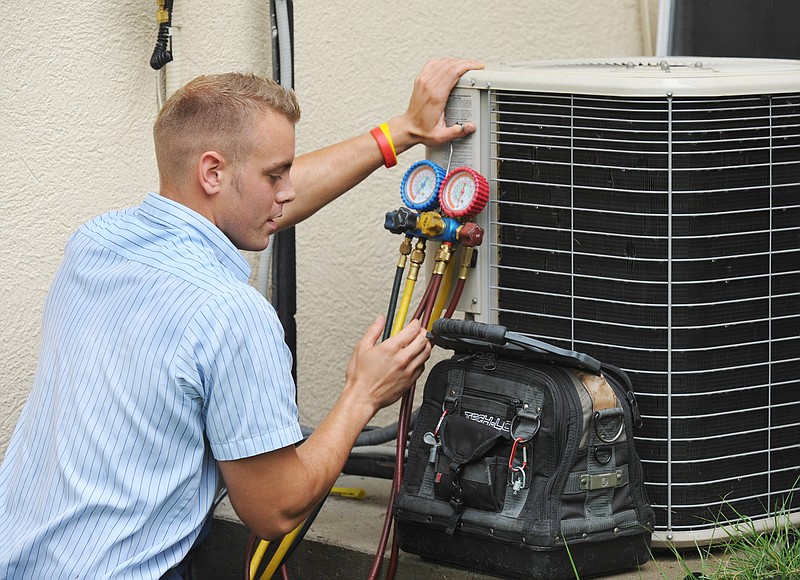With a campaign aimed at reducing energy consumption and cost, Ameren Missouri now offers monetary incentives to customers who update or replace existing heating and cooling systems with alternatives of greater efficiency levels, according to Cara Dolly, energy efficiency expert at Ameren Missouri.
As the sultriness of the Missouri summer weather tempts consumers to cool down homes and businesses with costly air conditioning systems, the Coolsavers portion of the Act on Energy program has grown in popularity, Dolly said.
"This program will offset the needs to build onto new power plants and reduce to the cost to serve customers," Dolly said.
Ameren is investing $147 million in the campaign and hopes to reduce energy by 800 million kilowatt hours, she said.
Among other options, the Coolsavers program provides rebates to customers who utilize one of the several Ameren-authorized contractors for an air conditioner replacement or tune-up, according to the Act on Energy website.
Customers may be eligible for a maximum $425 rebate for an air conditioner replacement and a maximum $75 rebate for an air conditioner tune-up.
Heating and cooling systems must meet a specified Seasonal Energy Efficiency Ratio level, which can be verified by a local contractor, in order to earn the customer the rebate.
There is a "multitude of good reasons" for customers to use the Coolsavers program including the reduction of monthly utility bills, half of which accounts for heating and cooling processes, according to an Ameren Missouri statistic, Dolly said.
With energy efficient appliances, consumers have the "option of not spending as much," Dolly said.
Energy efficient appliances and cooling systems also give consumers an attractive modernization in household technology that can "enhance homes," Dolly said.
"A lot of people need to update appliances. They're going to have to replace it. They want an energy efficient product," Dolly said.
The Coolsavers program also ameliorates the local economy because it sends consumers to local contractors for installation processes, Dolly said.
Aire Serve Vice President Rob Sachse has participated in the Coolsavers program as a local contractor and has installed 15 to 20 energy efficient heating and cooling systems so far this summer, he said.
Sachse said the program "helps customers."
"Electric rates have gone up. It's anything Ameren can do to offset the cost," he said.
Though Sachse recommends a more efficient system, Aire Serve offers different levels of efficiency from which customers may select a system; however, 70 percent of Sachse's customers tend to select a system with greater efficiency, he said.
Though the lifetime cost of the energy efficient system is less than a conventional version, upfront costs of a more efficient system may be $1,000 to $3,000 higher, depending on the SEER rating of the system, Sachse said.
Shawn Rackers, a sales estimator at Woodman Engineering, echoed Sachse's sentiments regarding the advantages of energy efficient heating and cooling systems.
"With the money back upfront, plus the longevity of utility savings, it only makes sense," Rackers said.
About 75 percent of the air conditioning systems Rackers has installed recently are those eligible for rebates under the Coolsavers program, Rackers said.
Rackers has received many inquiries concerning the Coolsavers program and benefits of energy efficient appliances, he said.
"People are more educated and aware," he said.
Despite consumer knowledge of the merit of energy efficient heating and cooling systems, Rackers said some customers decline to invest in an energy efficient because of the hefty upfront cost.
"With the economy the way it is, people get equipment to last longer. They won't replace stuff if they don't have to," he said.
Reflecting views of Rackers, Andrew Rotballs, owner of Bemboom Heating and Cooling, has spoken with several consumers dissuaded from investing in heating and cooling systems of high efficiency levels because of the costly initial expense.
"Jeff City is conservative. There is nothing wrong with that but if they (local consumers) don't need it, they're not going to buy it," Rotballs said.
According to Rotballs, the installation of an energy efficient system could cost from about $7,500 to $8,500, whereas a more conventional model may be as much as $1,200 less expensive.
Rotballs did, however, acknowledge the savings available as a result of the installment of an energy efficient system.
"When it's in use, you do see savings. It's just a lot more expensive upfront," he said.
Rotballs cited the Ameren rebate as more of an added incentive compared to the appeal of savings over many years, which is often the primary reason for purchasing the system.
"...if you get it (Ameren Missouri rebate) it helps out. People don't look at just the rebate for the reason to change their equipment. It's more like a Christmas bonus," he said.
Rotballs installed an energy efficient heating and cooling system in his own home and has been "impressed with the electric bill," he said.
Characterizing the purchase of an energy efficient heating and cooling systems as a long-term investment, Rotballs emphasized that customers planning to remain in their home for 10 to 15 years will see a return on their money.
"With middle-aged people, I can get them to see the point of doing it and getting the rebate," he said.
Though Rotballs touted energy efficient heating and cooling systems, purchasing a new system, even one that does not meet efficiency qualifications for the rebate, could reduce utility bills.
"Even if you have a '90s model, the replace it with a cheap one, you will save $50 to $70 dollars a month," he said.

